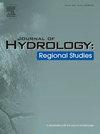Weakening greenhouse gas sink of intermittent river under human activities for the Inner Mongolia grassland region in China
IF 4.7
2区 地球科学
Q1 WATER RESOURCES
引用次数: 0
Abstract
Study region
This study was conducted in the Tabu River Basin, located within the Yinshanbeilu Grassland in central Inner Mongolia Autonomous Region, China.
Study focus
The Tabu River's runoff is significantly affected by human activities. This study investigated the spatiotemporal dynamics of the CO2 flux under varying runoff conditions, identified the key drivers of CO2 emissions, and assessed the influence of human activities on these emissions within the watershed.
New hydrological insights for the region
Our findings revealed a significant decline in runoff in the Tabu River Basin since 2010, primarily driven by human activities. Following river drying, riverbed ecosystem respiration (ER) increased, whereas riparian wetlands exhibited a marked decrease in ER. Furthermore, net ecosystem exchange (NEE) results indicated a shift from a carbon sink to a carbon source in the riparian wetlands during periods of river drying. Soil moisture content (SMC), above-ground biomass (Bios), and soil bulk density (ρb) emerged as critical factors regulating CO2 emissions. These findings highlight the necessity for continuous, long-term monitoring of intermittent rivers and in-situ greenhouse gas flux measurements under diverse hydrological conditions. To enhance the resilience of riverine ecosystems and sustain their carbon sequestration potential, future management of the Tabu River Basin should focus on optimizing irrigation strategies and adapting reservoir management practices. Such interventions will enable efficient allocation and sustainable utilization of water resources.
中国内蒙古草原地区人类活动下间歇性河流温室气体汇的削弱
本文章由计算机程序翻译,如有差异,请以英文原文为准。
求助全文
约1分钟内获得全文
求助全文
来源期刊

Journal of Hydrology-Regional Studies
Earth and Planetary Sciences-Earth and Planetary Sciences (miscellaneous)
CiteScore
6.70
自引率
8.50%
发文量
284
审稿时长
60 days
期刊介绍:
Journal of Hydrology: Regional Studies publishes original research papers enhancing the science of hydrology and aiming at region-specific problems, past and future conditions, analysis, review and solutions. The journal particularly welcomes research papers that deliver new insights into region-specific hydrological processes and responses to changing conditions, as well as contributions that incorporate interdisciplinarity and translational science.
 求助内容:
求助内容: 应助结果提醒方式:
应助结果提醒方式:


